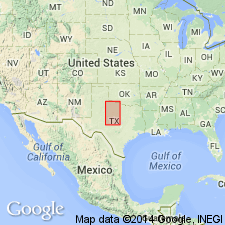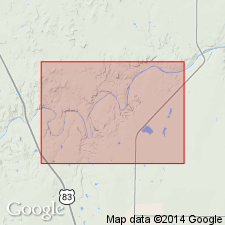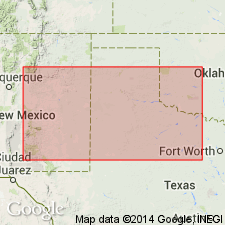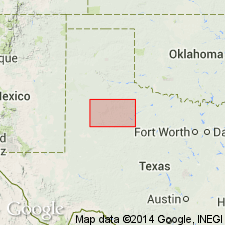
- Usage in publication:
-
- Aspermont dolomite
- Modifications:
-
- Original reference
- Dominant lithology:
-
- Dolomite
- AAPG geologic province:
-
- Permian basin
Summary:
Sec. opp. p. 96 (pl.). Aspermont dolomite. 1 foot thick, lies 105+/- feet below top of Greer formation. [Age is Permian.]
[Probably named from Aspermont, Stonewall Co., central northern TX.]
Source: US geologic names lexicon (USGS Bull. 896, p. 83).

- Usage in publication:
-
- Aspermont dolomite
- Modifications:
-
- Revised
- AAPG geologic province:
-
- Palo Duro basin
- Permian basin
Summary:
Pl. 1. Aspermont dolomite is older than Royston formation and younger than McCaulley dolomite; all included in Double Mountain group. [Age is Permian.]
Source: US geologic names lexicon (USGS Bull. 896, p. 83).

- Usage in publication:
-
- Aspermont dolomite
- Modifications:
-
- Overview
- AAPG geologic province:
-
- Palo Duro basin
- Permian basin
Summary:
Pg. 955-956. Aspermont dolomite. Some geologists correlate Guthrie dolomite with the Aspermont dolomite; others believe Guthrie is older than Aspermont. [Age is Permian.]
Source: US geologic names lexicon (USGS Bull. 896, p. 83).

- Usage in publication:
-
- Aspermont dolomite†
- Modifications:
-
- Abandoned
- AAPG geologic province:
-
- Palo Duro basin
- Permian basin
Summary:
Pg. 168. Aspermont dolomite is same as Guthrie dolomite and is discarded, Guthrie having been more commonly used. It is in Blaine formation.
Source: US geologic names lexicon (USGS Bull. 896, p. 83).

- Usage in publication:
-
- Aspermont member
- Modifications:
-
- Areal extent
- AAPG geologic province:
-
- Palo Duro basin
Summary:
Pg. 686, 697. Aspermont member, middle member of Dog Creek formation. Shown on chart as underlying unnamed shales and gypsums below Childress member and overlying shales above Guthrie member. Noted as occurring in Harmon County, Oklahoma. [Age is Permian.]
Source: US geologic names lexicon (USGS Bull. 1200, p. 155).

- Usage in publication:
-
- Aspermont Dolomite [unranked]
- Modifications:
-
- Mapped 1:250k
- Dominant lithology:
-
- Dolomite
- AAPG geologic province:
-
- Palo Duro basin
- Permian basin
Summary:
Aspermont Dolomite [unranked] in middle part of Blaine Formation. Age is Permian.
[Mapped in Cottle, King, and Stonewall Counties, TX.]
Source: Publication.
For more information, please contact Nancy Stamm, Geologic Names Committee Secretary.
Asterisk (*) indicates published by U.S. Geological Survey authors.
"No current usage" (†) implies that a name has been abandoned or has fallen into disuse. Former usage and, if known, replacement name given in parentheses ( ).
Slash (/) indicates name conflicts with nomenclatural guidelines (CSN, 1933; ACSN, 1961, 1970; NACSN, 1983, 2005, 2021). May be explained within brackets ([ ]).

